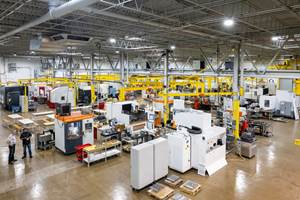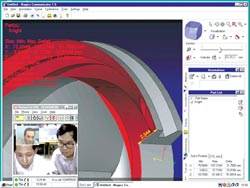Designing the Moldmaking Industry's Future
The role of the mold designer has changed greatly in the past 20 years, and it is up to the moldmaker to ensure that the next generation is properly trained.
Back in the early 70s, those just starting out in their first mold design job may remember the typical attitude of mold shop owners: "I don't need a mold designer. Just give me a part drawing and a blank pad of paper and I'll build the mold."
Back then, that would be true of many who were in the moldmaking trade, but not so today. The skilled moldmaker of yester-day is a scarce commodity in today's market. No longer do you see the man who can "do it all." Today, the moldmaking shop is filled with specialists and the moldmaker is the man who fits the mold at final assembly.
In this new era of technology, mold-makers have taken advantage of the speed and accuracy of CAD, and as a result, a mold designer's value has risen - and rightly so.
No longer is the mold design process someone bending over a drafting board - vellum paper hanging over the edge - drawing lines with a lead holder and straight edge.
The days are gone when moldmakers did their math problems with a blank pad, a calculator and a Trig book. Much has changed in the industry throughout the last 20-plus years, including the role of the mold designer in the moldmaking industry.
Whether it's as a member of an in-house design staff or a contract designer, the mold designer is now setting the pace in many companies. He/she has been given the mantle of versatility. He/she is expected to know more than how to design a mold and detail the components.
It is important for moldmakers to remember that a mold designer can be a benefit to all moldmaking shops that use an outside design service as well as for those with in-house staffing, and it is your responsibility to better train and assist these designers with the goal of making your business a success.
Training the Mold Designer
The most valuable tool that the industry can give new mold designers is good training and a good mentor who leads by instruction and example. Back in what was called the "Stone Age," when there was limited or no trade schooling available, strong mentors were needed to guide the industry.
Even today, in order to keep this industry strong, those with experience need to realize the importance of properly training those entering the field. Yes, there is a cost, but that cost is related to the industry's livelihood. Where is the industry or trade going to be if new craftsmen aren't trained for the future?
Training for the mold design position will come in different shapes and sizes depending if it comes from a contract design house, a moldmaking shop that has in-house design or a custom molder who is a one-stop shop for design, moldmaking and molding production.
Let's take a look at each and see how you can build a brighter future in training the new designer as well as adding value to those who are already working for you.
The Contract Design House
The contract design house or service is generally running from one job to the next, trying to meet a tight deadline. In between design jobs (and most of the time during), the owner is developing new customer contacts, reviewing completed designs and trying to project his schedule for the designs he has.
It would take a truly talented individual to take on and train an apprentice from scratch. Usually in this situation, the owner needs a designer who already has some experience, whether it be detailing or designing the mold.
Training here will be "from the seat of their pants." In other words, they will learn from job to job, customer to customer, and will directly see their input into the design and its success or failure.
It is important for the owner/designer to grow those working for him and to provide exposure to the designs on which they have worked. When possible, the owner should arrange for the apprentice to visit the moldmaker at the final assembly of the mold to see how it went together and to gain feedback. Also, the same goes for the sample test. There is nothing like seeing something that you've designed producing parts and learning what you could have done better.
Outside training for the contract design house is usually minimal. If any training can be done, it will be after hours or the designer will be expected to make up the lost time. One thing to remember here is the importance of investing in a person and how that investment will create returns for the business.
The In-House Design Shop
Next, let's look at the moldmaking shop that has its own design group. This is where the best training ground could be for the new mold designer and the veteran who wants to expand his skills and exposure.
The manager of this group needs to take a strong ownership in the designers and have the desire to develop and grow the department. Because of the profit margin that a toolroom runs under, it can often afford training and exposure for the designer that will relate to increased productivity and creative designs.
It is best to have the designer involved with the launching of the projects. Not necessarily with input, but to understand a company's procedures at first. This goes for the hand-off to the toolroom as well. It is informative to watch the design go from print to steel.
If the workload is a bit light in design, let the mold designer assist the lead moldmaker of that job. It provides insights into the construction of the mold, a feeling of ownership and a sense of being "in the loop" as the work progresses through the shop.
Finally, the designer should - whenever possible - be a part of the initial mold sample. Again, this is building and developing the designer's skills. The designer will understand firsthand how the mold fits into the press, how the mold is set up and what might have been a better way of doing the mold layout.
In this area, you also can find out if your designer is picking up trade skills that relate to his job. What is he/she learning about water connections and flow? What about runner sizing as it relates to flow length and the selected material? Remember your invest-ment - you want it to return a dividend.
Have your designer always update his own work when possible. Don't let him/her get too busy to miss this important area, even if he/she is a designer of many years. Everybody learns from others as well as their own mistakes.
The Custom Molder
Finally, the mold designer in the custom/captive injection molding company will have many opportunities like the designer who is in the moldmaking shop. There are benefits and advantages for working for a molder.
First, the molding is done at the facility. Within minutes you can see how many different types of molds are running, as opposed to having to leave the shop and drive to who knows where to watch the mold run. The second benefit is the opportunity to develop relationships with craftsmen in the other disciplines of the industry. Learning from each other makes the industry and its jobs better. Third - and this is so very important - the company permits the designer to become part of the team throughout the process, not just at the end.
As the designer starts to make contacts with vendors and suppliers, he/she is given the chance to see how everything works together and gives vision to improving the process that others might have missed because "we've always done it this way."
The New Role
The mold designer is becoming the "go to" person in many moldmaking shops where the moldmaker has been replaced by work center specialists or skilled machinists. With the engineering of the mold taking place up front instead of on the shop floor, the mold designer is a valuable asset that each company needs to guard. They do not come out of college or a trade school ready to hit the ground running, but are directed by mentors who see the value that it will give to the plastics industry, as well as the value returned to the company.
As the owner of a company or manager of a toolroom or design department, you need to grow the talent that you have. Give a comfortable working environment to them. It doesn't have to be fancy. But it needs to be a place where they will enjoy working. Give them exposure to the industry. There are times that the designer needs to be focused on what he/she is doing. Let's face it, mold costs are going up and you are entrusting a large cash investment with him/her, so give the designer as much of a disruption-free place to work that you can. As the designer grows, he/she can deal with more.
Invest in training. This can include the software that is used, seminars at trade shows and attendance with pay at local trade shows. Make sure that there are trade-related publications available. When you are able to budget the cost, send your designers to larger trade shows or seminars. This accomplishes two objectives: one is continued training and investment in a valued employee, the second is a satisfied employee. Why would your designer go elsewhere when he/she knows you care so much?
The mold designer will give much more back to a company than a quality mold design. He/she will find ways to make his/her work better, yet easier. The designer will add value to a mold that isn't always recognized by the boss, but is seen by those who have to build from the design or run the mold in production. The final reward to the designer is a mold that can run long beyond the life of the product it was designed for.
Related Content
Cross Training, In-House Capabilities and Collaborative Design Move Helm Tool Forward
Cross-training, bringing it all in-house, molding and collaborative design are essential to Helm Tool's success.
Read MoreUnique Mold Design Apprenticeship Using Untapped Resources
To help fill his mold design skills gap, Jeff Mertz of Anova Innovations, is focused on high schools and underprivileged school districts, a school that has lower graduation and college entrance rates. The goal is a student-run enterprise.
Read MoreHands-on Workshop Teaches Mold Maintenance Process
Intensive workshop teaches the process of mold maintenance to help put an end to the firefighting culture of many toolrooms.
Read MoreTackling a Mold Designer Shortage
Survey findings reveal a shortage of skilled mold designers and engineers in the moldmaking community, calling for intervention through educational programs and exploration of training alternatives while seeking input from those who have addressed the issue successfully.
Read MoreRead Next
Mold Designers Put the Web to Work
The internet is redefining the tool-design process. Some mold designers are finding that using the Web to manage a tool project can shorten lead times, cut costs, and make sure vital data get to all participants in a project.
Read MoreHow to Use Continuing Education to Remain Competitive in Moldmaking
Continued training helps moldmakers make tooling decisions and properly use the latest cutting tool to efficiently machine high-quality molds.
Read MoreAre You a Moldmaker Considering 3D Printing? Consider the 3D Printing Workshop at NPE2024
Presentations will cover 3D printing for mold tooling, material innovation, product development, bridge production and full-scale, high-volume additive manufacturing.
Read More
























